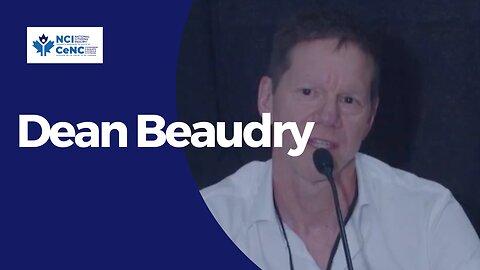Dean Beaudry, a 30 year engineer working for Syncrude as a risk assessment and mitigation manager, describes the failure of Canada’s healthcare leadership to follow essential risk management practices during the COVID crisis, as well as lack of accountability and competence of such leadership. Mr. Beaudry said, “when you’re making a decision, it has to be based on facts or well-corroborated opinions, and minimize the assumptions. I can’t see any evidence of that having occurred.”
* The above video is being streamed via Rumble. Check back often as we continue to update the complete list of links to all witness testimonies in both video and audio/podcast formats.
[00:00:00]
[No audio until 00:01:14]
Dean Beaudry
My name is Dean Beaudry, D-E-A-N B-E-A-U-D-R-Y.
Leighton Grey
Mr. Beaudry, do you promise to tell the truth, the whole truth, and nothing but the truth in this proceeding?
Dean Beaudry
I do.
Leighton Grey
All right. Sir, I’ve mentioned earlier your education and your background. I’d like to go into this a little bit more before we dive into your presentation. I understand that you spent about 30 years working for Syncrude in Fort McMurray, working on multibillion dollar projects in terms of managing risk assessment and mitigation methods. Is that right?
Dean Beaudry
That’s correct.
Leighton Grey
You retired about seven years ago, and you now live in Cochrane?
Dean Beaudry
Right.
Leighton Grey
Okay. So I understand that you’ve developed a presentation called Quality Decisions in High-Stakes Situations. Before you delve into that, I wonder if you could just give us an idea of what caused you to create this presentation. What was your motivation? Inspiration? Your muse?
Dean Beaudry
Well, I was asked to present, so I had to find something to present. I volunteered to be part of this initiative, and someone picked up that I had background in risk management. So when I was asked to talk about it, I had to do a lot of homework. If I’m honest about this, I’ve been working pretty hard on this for about a month. I made many more slides than I’m actually going to present today, and I had to pare it down. So I’m going to not only talk about risk management but a little bit of management in general. And I’ll also say that within my career, at least a dozen times, I’ve been the lead investigator in major incidents and had to produce reports for that. What I’m presenting is kind of like that work, that I’m quite familiar with.
Leighton Grey
I wonder if you wouldn’t mind then going into your presentation [Exhibit RE-5-Beaudry-Presentation re NCI Red Deer-Final], and then I’ll have a question or two afterwards once you’ve completed that.
Dean Beaudry
Sure. Okay, this is kind of like a movie where the movie gives you the end. You get to hear the end part of the movie first. I framed it this way because I think what I have to present will be more understandable in the context of this.
This diagram is a root cause analysis. When you have an event like we’ve had where Canadians have suffered, basically, you ask the question, “Why?” There’s lots of detail in here you can look at as I’m talking; I’m not going to go into it in great detail. But what you’ll see in the next two pages is I get these down to what we call in investigations “the root cause.”
So just as an example. We’ll start with, Canadians suffered severe social, emotional, educational, mental and physical health, and economic consequences as a result of federal and medical governance and COVID actions. So you ask, Why? Why did that occur? So on the left-hand side: The priority was higher for
[00:05:00]
COVID over equally important health and national issues. Well, why was the priority higher? And there’s two roots below that. They are, procedures that balanced priorities were dismissed as well as international experts and Canadian stakeholders calling for balancing of priorities, were dismissed.
We’ll go over to the right-hand side and look at another “why” Canadians suffered. Well, there was high levels of social isolation, division, and fear. Why did that occur? Well, the unvaccinated, unmasked, and dissenting opinions were vilified; COVID mitigations caused isolation; and fear was used to drive compliance. So I’m just going to leave it there. But I’m going to talk to the roots that are highlighted.
So one root was, scientific process was not followed. So when you follow a scientific process, ideally, you get to what’s true and right. And then, on the right-hand side, there’s a root there, “The vision and values that once defined us as Canadians has waned.” We’re not quite the same nation we used to be. If you have good vision and values, you have the conviction to do what’s right. So in essence, you could stop there. If we know what’s true and right and we do what’s true and right, we don’t have this fairly terrible outcome.
But there’s other reasons. And another root that I end up on this page with is a “Broken consequence model,” which we’ll elaborate on further. And just to carry on and finish the root cause, one of the roots was “Unchecked and inadequate governance action.” Well, why did that occur? Well, there was public trust. And why did public trust occur? Well, I think there was some naivete. And also you get down to “The government has a lot of influence on media.”
I think, probably the biggest root for unchecked governance action was “Undue authority.” And why did that happen? Well, there was a suspension of Charter rights and that provided the authority for general lowering of ethical and privacy standards, coercive vaccination requirements, vaccine passports, travel restrictions, lockdowns, all the bad things that happened. But also it eliminated the requirement for critical thinking and difficult decisions.
So I was a manager for 20 years. I had management peers, and the easy answer was always, “Give me more money. I got a problem. I need more money.” Well, when you give a manager some more money, they just spend it rather than critically think. And so sometimes we have to have a pause to cause ourselves to think harder.
Leighton Grey
Sorry, did you say manager or cabinet minister? I didn’t catch that.
Dean Beaudry
I was a manager. So when we do a decision, it’s not that complicated. There’s
priority, information, alternatives. You do a deliberation, and you come up with a decision. In my experience, high-stake decisions always have tension. This isn’t a new thing. Any business that has risk in it is doing this all the time. So we in Canada, we end up with a big risk. Those decisions have tension. And that tension can be good or bad. So to push it on the good side, there’s some guideposts that we use. And the first one is around emotion.
Emotion has really no place in a high-stakes decision. We need to detach from emotion. I’ll give you a personal example. So about 30 years ago my wife and I took a rock-climbing course, and I found myself 20 feet above the ground many times. But this one time, I had worked out really hard before I climbed up 20 feet. I got 20 feet up, and my muscles started failing. And my hands start shaking, and my legs are shaking. And then fear begins to grip me. I was paralyzed with fear. I had full fall protection. I could only fall six inches. But I was paralyzed with fear. So reality and my emotions were not connected at all.
[00:10:00]
And so, we have to disconnect from our emotions. You also have to disconnect from other people’s emotions.
So there is a number of decisions that I’ve made in my career where I’ve actually had people right in my face telling me I was trying to kill them. And that’s a pretty tough spot to be. We need to honour those emotions. And in circumstances that occurred like that, I would sit down with the individual and give them the background to the decision, all the data that was used in the input of the decision to help them get more comfortable for what we’re going to do. In fact, on one occasion, I had an individual in my office making a declaration like that. I said, “What time are you doing the job?” “Why?” “Because I’m going to come out and stand beside you.” And he said, “Okay. That’s good enough.” I didn’t even have to give him an explanation. I’m willing to do what I’m asking you to do.
The second emotional thing is cognitive dissonance. So we all develop our own opinions, and sometimes we get new data that conflicts with what we think. When we are dismissive of that data, that’s called cognitive dissonance: where what we feel and the information actually are in conflict. So that’s why emotion is a really bad thing to use in a difficult decision.
The next guidepost is around authority. So authority needs to come from knowledge and sound judgment. People have positional authority. That’s a bad place for decisions to come from. A person in a positional authority should be ensuring that knowledge and sound judgment is used versus just making the decision. I see that failure occurring too often.
Another important guidepost is your character. So there’s ethics and accountability. On the ethics side, if there’s a conflict of interest you need to declare it and take yourself out of the decision. Or, at least, declare it so that people know what your bias is. And then accountability, which is people’s ability to count on you. If you’re not willing to put yourself in the position of someone who might suffer a negative consequence as a result of your decision, you are not accountable. If you’re not willing to take negative consequences yourself when you make bad decisions, you are not accountable.
And then competence. It’s funny that competence is the lowest one on the list; it’s important, but it’s not the most important. So you have to have the competence to ensure that you’ve got the right priority and the right information and the right alternatives. And typically, that doesn’t exist in one or two people. Typically, you don’t do well unless you have people with different biases involved.
So the strategy for minimizing failure points is to bring everybody on the same side, which can be really hard when you’ve got strong biases. In order to make that work, you need some ground rules, guiding principles or values, and you need a process. I’m a trained facilitator in situation appraisal, problem-solving and decision-making, risk assessment, and management. There’s tools, they call them instruments, that help guide groups with dissenting opinions to a good answer. So if you’ve got ground rules and a process and a group facilitator, you’ve got a better chance of achieving a good result.
Consensus is what you’re trying to achieve. And that’s not necessarily agreement, but the participants can live with and support the priority and the information, the alternatives, and the decisions. Once they support it, they’re bound to support it publicly. So you can’t be involved in this and agree in the group and then go outside and say, “I don’t agree with what everybody said or did.” You might not like it. But you understand, and you find it acceptable, and that’s really what consensus is.
Applied science is a process. So we didn’t do applied science: The only reason not to do this is when control is prioritized over doing what’s right. And that’s a values failure.
So here’s, from where I used to work, most of our guiding principles. I’ll just read a couple of them to you. I think you might agree that it’s easy to get agreement on these types of principles.
[00:15:00]
“We have the courage and conviction to do what is right: we achieve our results with courage, wisdom, and integrity, being ethical in all of our endeavours, principled in our decisions, and accountable for our actions.
“We interact with care, honesty, and respect: we uphold the dignity and worth of our colleagues and everyone we interact with in our communities.”
So really, these principles, I’m not going to read them all, but they answer things like priority. They answer things like stakeholder engagement, character. And then they answer where we get our authority to make a decision.
So now we’re into the meat of things. This colourful table is called a risk matrix. When we do risk assessment, when we evaluate risk, when we evaluate mitigations, we use a risk matrix. Lots of people believe that risk is consequence: I’m going to suffer death. That’s only half of the equation. We also need to put probability into that. So there’s some tables on the right that show probabilities, and really, probability is just a number. We’ve got some word descriptions like, it’s a “likely” probability; it’s an “unlikely” probability, “rare.” But those all translate to numbers, and the numbers are on the page there. And then consequence, we’ve talked about death as a consequence, that’s also on the table, on the right.
So just to put this in context, I’ve got an example. In 2020, there were 15,000 accidents that were fatal in Canada. So the probability is grade four math; I’m an expert in grade four math: 15,000 over the population of Canada gives you a number, and that’s a Probability 2. See over here. So a Probability 2. And it’s a fatal accident, so it’s a C4 [Consequence 4]. When we put it on the matrix, it looks like that [generalized Medium Risk 8].
When we’ve got a new risk coming up, we should be comparing it to a risk we’re familiar with. Because new risks are- They get into your emotions if it’s something really unfamiliar. So accidental death in Canada: it’s a generalized Medium Risk. It’s an everyday risk we’re at peace with and we all tolerate. We apply diligence to it, but we’re not stressed out. I drove from Cochrane today: I wasn’t stressed out driving here; I could have been in an accident. So it turns out that the generalized COVID risk is exactly the same as accident risk. And I’ll show you that a little bit later.
What is risk mitigation? Risk mitigation is putting a barrier in front of the hazard. So ones we’re familiar with are seat belts and airbags, and they address consequences. They aren’t helpful if you’re not in an accident. But if you’re in an accident, they reduce the probability that you will be harmed more than you would if you didn’t have those mitigations in place.
Probability mitigations are those actions that you take to reduce the probability of something happening. So attentive driving is a good example: if you’re paying attention to your text, your cell phone, your probability of being in an accident gets higher.
Mitigation effectiveness assessment: In risk management, when you add a mitigation, you have to evaluate it. Does it cause a change to the risk position on the risk matrix? So if we go back [Risk Matrix Table], If I’m going to mitigate, say, something up here, it should cause a change in position. It should be down and to the left. So that’s what it means, that we need to change the position in the risk matrix.
Does it introduce new risks? Because, sometimes, mitigations do. And airbags are a good example of that. So airbags introduce a new risk to small children. That’s why they had to add a mitigation on the mitigation. That’s why when I’ve got my grand puppy in the seat beside me, the airbag is not deployed because the dog weighs less than what’s safe for that airbag to deploy. And then, is there cost benefit?
[00:20:00]
And, again, if there’s new risks, are they mitigated?
So let’s get into a little bit more detail. This table [COVID Risk Factors], the first column is age group. All the data that I will use relative to COVID comes from Government websites. So the first column is the age group. The third column is the number of deaths that occurred in Alberta in those age groups. The fourth column is the number of people in that age group. What we see is that the average age of COVID death is 79, and 99 per cent of deaths were over 40-years-old. And nine one-hundredths of one per cent [0.09 per cent] were in the under-20 age group.
So I heard a little discussion earlier about pre-existing conditions. I pulled this off of the Alberta website. You can’t find it anymore. I just happened to get it before it was taken down. And we can summarize some things from this. The average number of pre-existing conditions of a COVID victim was 2.6 or more. You’ll see this red part of the chart here; it says three or more. So that’s why when I average it, I say 2.6 or more. Ninety-six per cent of COVID deaths had at least one pre-existing condition, and four per cent of COVID deaths had no pre-existing condition at all.
I also took another snapshot down. It is now disappeared, but it came from the Alberta Health website. In the four months leading up to early June 2022, there were 868 COVID deaths: 79 per cent of those were vaccinated; 21 were not vaccinated. At this time, Alberta’s vaccine, unvaxxed ratio was 77Ð23. So vaccination didn’t stop anything: infection, transmission, or death. I’m not saying vaccines didn’t have some impact for some people. I’m just saying this is a factually correct statement.
So now let’s put these age groups on that colourful risk matrix. If you look at this table over here [Probability vs Reference Risk], each of the age groups is labelled with a letter designation. If you look on the matrix, I’ve had to add boxes for D and E, so the people under 40 aren’t even on the risk matrix. I want to make sure I’m clear: I’ve added those boxes; they aren’t on the risk matrix. So if you’re in a business and you are good at managing risk, you do not put a mitigation in for something that’s not on the risk matrix. It’s illogical.
Now, there were 32-and-a-half million vaccinated Canadians: that’s from the Canada Health website; that’s people that had two jabs. There were 10,685 serious adverse events. We just do our grade four math, and we get a number [10,685/32.5 million = 0.00033]. So we’re not talking about death here; we’re talking about a serious. So we’re in this column [C3, Significant] and this probability [P2, Unlikely].
Okay, so what are these serious adverse events? This is again from the Canadian website: 427 deaths reported; 1,500 cardiac; 1,500 clotting; 87 spontaneous abortion; 468 paralysis and stroke. And we’ve got a safe vaccine. So if we look at just the deaths and we do 427 over 32-and-a-half million, we end up with 1 in 75,000, which is also off the risk matrix. So from the perspective of death as a result of the vaccine, it is an acceptable risk.
So this analysis is more like an autopsy; it’s based on what’s already happened. Health Canada statement says, “The benefits of all COVID-19 vaccines continue to outweigh the risks of the disease.”
Well, what about the risk of vaccine injury? So for the under-20 age group, 670,000 people would have to be vaccinated to save one life, and that would probably result in a vaccine injury to 221 people,
[00:25:00]
including nine deaths. So the harm far outweighs the benefit. So I don’t know what risk matrix they’re using, but the one I have 20 years of experience, or close to 30 years” experience in, wouldn’t support some of the statements that they’ve made.
So when we talk about moving on the risk matrix, you’ll see the people in age group A would move with the mitigation down and to the left, which is what we want. The people in group B would move to the left, which is what we want. The people in groups C, D, and E would all be moving into a worse position on the risk matrix.
This isn’t new information. This was in the Great Barrington Declaration, which states, “We know that vulnerability to death from COVID-19 is more than a thousand-fold higher in the old and infirm than the young. Indeed, for children, COVID-19 is less dangerous than many other harms, including influenza.Ó So I looked at the influenza results for Alberta this year. There’s been three influenza deaths in the 0-19 age category; thatÕs higher than the annual rate of COVID.
So let’s talk a little bit more vaccine risk benefit. I’ll explain this table a little bit. The age group is in the first column. The number of people that have to be vaccinated depends on the efficacy of the vaccine. If you want to save one life in the under-five age group and the vaccine efficacy is 50 per cent, you have to vaccinate 1.5 million of these children. If the efficacy is 25 per cent, you have to vaccinate 3 million. But when you do that, if you apply the injury and death rate, you can see that anything that’s in the red, you just don’t want to do it. So Health Canada implies that vaccines are safe at one death per 75,000 vaccinated, two-jab people. Using the same criteria, you are safe from COVID in the red shaded area without vaccination. So we have this data available to us, and it would been available within the first six months. They would have been able to see the stats rolling in. Perhaps we could have had a health care practitioner that could use tables like these to provide vaccination guidance to individuals or groups based on age, pre-existing conditions, risk tolerance, and vaccine efficacy.
It’s interesting that 10 countries didn’t have a pandemic. So Nigeria, Republic of Congo, Tanzania, Niger, and there’s six other countries like that that have deaths in the 15 people per million population as a result of COVID. Of the 10 countries that had a population of 438 million and compared to G7 countries, they did between 1 and 200 times better. So I heard someone say earlier: “We’re not a third world country.” I kind of wish we were a third world country. For Canada, the results would have meant about 98 per cent reduction or 50,000 fewer deaths. So my question is, Wouldn’t science or just due diligence want to know why 10 countries did not have a pandemic? And didn’t we have the money to assess this? We built up half a trillion dollars in debt. Couldn’t we have sent someone to investigate this and understand it? Ironically, all 10 of those no-pandemic nations have endemic malaria, so they use anti-parasitics.
Lockdown effectiveness. So Sweden, they delegated down in their bureaucracy to the state epidemiologist who said, “The cost of locking down would be horrifyingly high.” He’s a prophet. So the Swedish population had a few restrictions, but most COVID measures were entirely voluntary. And this chart compares the U.K., or Britain, to Sweden. Britain had fairly severe lockdowns. Sweden had none. If you look at the two traces,
[00:30:00]
they’re pretty close to on top of each other. And if you look at the data, when we had the data, you look at these first two bumps. This line [green line] represents the end of 2020: at this point, you could write a master’s thesis on this data and make decisions from it. So Sweden, without locking down, achieved better COVID results than other G7 nations, such as USA, Italy, U.K., France, who had some of the most stringent lockdowns. And the question, doesn’t science have curiosity? Don’t we want to understand how an alternative approach was working? Didn’t we have the money to research this?
And then, one more little point: South Dakota was the only state in the USA that had zero lockdowns. Twenty-one lockdown states had higher COVID deaths. South Dakota was right in the middle of the states in terms of their COVID deaths. So just another mitigation effectiveness point.
Another point here is if we’d applied lockdowns when death rates were going up and taken them off when death rates came down, reapplied, took them off, we would have convinced ourselves that we were doing something of value. Very good correlation here. No causation whatsoever.
So Alberta ICU [Intensive Care Unit]: two weeks to flatten the curve. So the blue line here is ICU capacity; the pink shaded area down below here is how full is the ICU. So in 1100 days, the ICU was overfull for 17. And it got to about 10 per cent overfull. Again, you can see the blue arrows up and down related to lockdowns increasing or decreasing. And there’s one more flag on here: This flag is, by the time we reached mid-July 2021, all the over-age-40 people or 99 per cent of the vulnerable people had been provided vaccine opportunities. I don’t know the rate at which they were vaccinated, but they were all provided the opportunity. And the peak in ICUs came after that. We, again, added half a trillion dollars in debt, and we didn’t build any more ICU capacity.
So masks, I just took one piece of information from the organization called Cochrane, and it’s got nothing to do with where I live. Its reviews have been considered the gold standard. And this is their statement: “There is just no evidence that masks make any difference. Full stop.”
Now, let’s talk about priorities. The legal priority of the Government is to uphold the Constitution, and within the Canadian Constitution is the Charter of Rights. The Charter of Rights protect freedom of association, expression, religion, et cetera. “In order to suspend these rights, section 1 requires that there must be evidence that either the state is in peril or the existence of the state is in peril.” So that’s words from Brian Peckford. And I was told also, to state that “Canadians are in peril.” Okay. The onus of proof on section 1 is on the person seeking to justify that limit, which in this case was the Government.
So here’s the top 10 leading causes of death in 2020. When we do our probability math, we see there’s actually two buckets on this page. Below the red line is Probability 1. Above the red line is Probability 2. And I also want to talk right now about what an emergency is. An emergency is an urgent, sudden, serious event or an unforeseen change in circumstances that necessitates immediate action to remedy harm or avert imminent danger to life, health, or property.
So if we go back to our accident example, on an individual basis when there’s an accident, someone might be bleeding, they need emergency assistance: we need an EMT [Emergency Medical Technician] there, lights and sirens, et cetera.
[00:35:00]
But when we’re talking about national, we’re not talking about that. We’re talking about the national risk and the national harm.
So the national harm. And this is really cold and unemotional. People die from COVID; people die from accidents. That’s really crappy. But we need to approach decisions like this without emotion. The national harm is death of four one-hundredths of one per cent [0.0004%] of the Canadian population each year. That’s what accidents are. It’s the same for COVID. And it continued to be the same for three years, and now it’s declining. This year it looks like it’ll be about 11,000. So it’s going to fall below the red line this year.
Which is more peril? Accidents or COVID? Accidents pick on everyone: COVID picks on the aged and infirm. Accidents are normalized: COVID is fear-producing. Accidents and COVID produce about the same number of deaths. Accidents produce 225,000 injuries a year: long-COVID, I don’t know. I couldn’t find data on that. For accidents, the mitigations are harmless to individuals and harmless to society, and are subject to proper legislative process. The mitigations for COVID cause loss and suffering to individuals, cause loss and suffering to the nation, were subject to coercion through unjustified emergency powers and medical ethical violations. Accidents are easily characterized: COVID competes with 2.6-plus other potential causes and pre-existing conditions.
So they’re the same. There is equal justification to suspend human rights to mitigate accidental deaths as COVID deaths. And I would say a mitigation that would be effective on accidents is to close highways to all but essential traffic. That sounds a bit absurd, doesn’t it? So when you’re looking at this, if you go back to the previous table [2020 Top 10 leading causes of death] and on the left-hand column, those were all labelled A, B, C, D, E, and you didn’t know where COVID was, you wouldn’t think it was an emergency because you got so much evidence that it’s not.
For a nation, the logical priority is to protect what underpins our needs. Same with a business. I worked where we had a goose that laid golden eggs, and business is the goose that lays the golden eggs: it pays for all basic needs of all individuals and is a source of all Government revenue and social security. And the hierarchy in business is production. Production underpins all business: the production of lumber, the production of wheat, the production of cattle, the production of minerals, the production of automobiles. That’s what our economy is built on. And thriving business leads to affordable food, energy, and housing, and supports the tax base.
So we’ve got legal priorities and we’ve got logical priorities. Let’s put those mitigations on the matrix [Mitigation Results]. I’m not going to go through what vaccinations and the mitigations did not do; I’ve already done that. But on the financial side, it didn’t take much homework to see some really disturbing things.
So per taxpayer, we’re going to be paying about $3,300 in debt servicing compared to 2019. So a two-income family, that’s $6,500. If someone has a $300,000 mortgage and they didn’t have a fixed rate, they’re going to be paying about $8,300 more. Rents are $2,000 a year or more. Food for a family of four, that’s from Dalhousie University, is up $4,000 since 2019. Heat and fuel is up $2,000. And I want to be really conservative in this number, and so I picked a conservative number: there’s 15.3 million households, works out to about $170 billion a year extra that Canadian families are going to have to pay.
[00:40:00]
And that’s not including paying down the debt, which really is just deferred tax. So our mitigations moved our national risk, which was a medium risk, to extreme.
Accountability. This chart shows a business here in the light blue, and at the top of the chart is the C-suite: the CEO [Chief Executive Officer], the CFO [Chief Financial Officer], Chief Medical Officer. In a private and publicly owned business, that suite of people have legal and personal accountability. If they make very bad decisions, they can go to jail. If they make poor business decisions, they can lose compensation. It’s what real accountability is about. Without consequences, there is no accountability. Immediate and certain consequences are strong; those can be as simple as a pat on the back or a boot print. Future and uncertain consequences are weak. I’ve probably done 2Ð300 performance appraisals in my career. And about 80 per cent of people really don’t connect with those very much. They don’t relate to them. It’s only once a year, and they don’t know what the outcome is going to be. So can you imagine if there’s an election every four years? That’s a really, really weak consequence.
So we have a broken consequence model [from slide].
Pfizer and Moderna had unprecedented revenue increases: Pfizer’s up 70 billion a year for at least two years now; Moderna is up 19 billion a year for at least two years. Moderna’s income was zero four years ago, and now they’re making 19 billion a year. The federal government contractually transferred liability for vaccine injuries from Pfizer and Moderna products to the Canadian taxpayers, and those contracts are unavailable for taxpayer review.
The federal government bureaucrats received $191 million in bonuses and raises throughout the pandemic. The MPs [Members of Parliament] received their automatic raises. The Canadian public received $170 billion worth of cost-of-living increases, and total deferred taxes went up by $566 billion. And that’s more than $50,000 per Canadian. So if you’re a family of four, that’s more than $200,000 in deferred tax that you will eventually have to pay.
The vaccine injured received pain, suffering, stigma, long waits, and claim scrutiny. Vaccine approvers and safety claims have not been publicly scrutinized.
Mainstream media news generally aligned with government narratives. CBC [Canadian Broadcasting Corporation] receives $1.2 billion in tax funding and received $85 million in raises and $99 million in leader bonuses over three years. Other mainstream media received $600 million in taxpayer-funded corporate welfare, while mainstream media shareholders received dividends.
Individual lawsuits aimed at holding the government to account have to secure independent legal financing. The government chooses the arbiters of these suits and uses taxpayer funding to defend its actions.
Medical governance has disciplined doctors for non-compliance to approved therapies. Have they disciplined doctors who advised further vaccination to the vaccine injured? (I don’t know.)
There are laws to ensure accountability of officers of private and publicly traded businesses. There are laws that indemnify elected officials.
Leadership. What we had was a reaction, and I would say an emotional reaction. What we want is vision. We want our basic needs met, and we don’t want them met by the government. We want them met by a good economy. And vision looks like freedom and opportunity. What we had was bullying, gaslighting, and emotion. What we want is knowledge and capability, and that looks like seeking and acting on wise counsel. This nation is filled with wise people. What we had was lack of transparency and “cover your butt.” What we want is commitment and accountability:
[00:45:00]
consequences commensurate with the result. What we had was division. What we want is unity and compassion, focusing on what brings us together. I took a cultural diversity course, I don’t know, 15 years ago. It was a three-day course, and I took away one thing: we’re all 90 per cent the same. Why do we focus on a 10 per cent difference?
So I’ll end with my prayers. God keep our land, glorious and free. You can look the other one up [II Chronicles 7:14]. Thanks.
Leighton Grey
Thank you, Mr. Beaudry. I wonder if you could turn to, I believe it’s the fourth slide in your presentation. It’s the one that has a strategy for minimizing failure points at the top. It talks about applied science as a process. That’s the one. I wonder if you could put in that little part at the bottom right-hand corner? Yes. [Graphic reads: “The only reason to not do this is when control is prioritized over doing what is right, a values failure.”]
I want to take what you said, and I want to put it in the form of what lawyers call “a hypothetical.” And when people hear the hypothetical, it’s going to sound hauntingly familiar.
So it turns out that what happened in this province, in Alberta, was that our government had no interest in a consensus process like you’ve described here. What we did instead is, under section 29 sub 4 of the Public Health Act, a Public Health Act dictator was set up. One person: Deena Hinshaw, Chief Medical Officer of Health. It seems to me that’s the beginnings of where we went wrong. But you say there, in the bottom right-hand corner of that graphic, “The only reason to not do this is when control is prioritized over doing what is right.”
I want to present you with a little hypothetical, and then I want to get your opinion about this.
Most people who have done any management training or taken an ethics course are familiar with something called the “dilemma of the trolley track.” It goes something like this. Trolley dilemma is an ethical thought experiment where there is a runaway trolley, a train, moving down railway tracks. In its path, there are five people tied up and unable to move, and the trolley is heading straight for them. People are told that they are standing some distance off in the train yard next to a lever. If they pull this lever, the trolley will switch to a different set of tracks but will kill only one person who is standing on the side track. People have the option to either do nothing, allow the trolley to kill the five people on the main track or pull the lever, diverting the trolley onto the side track, where it kills only one person. It seems that this has been presented many times all over the world. Results show that, over-ridingly, historically, people in Europe, Australia and the Americas (that’s us) were more willing than those in Eastern countries to switch the track or to sacrifice the man to save more lives. But in Eastern countries, such as China, Japan, and Korea, there were far lower rates of people likely to support this morally questionable view.
Let’s bring this closer to home. I actually put this trolley dilemma in some form to our Chief Medical Officer of Health when I had the opportunity to question her. I said to her, “Look, you knew that when you were imposing lockdown restrictions, you were suspending, violating the human rights, the civil liberties, you were destroying or upending their businesses, the economy, schools, all these things. You knew that. And you did it anyway.” Her answer was that, on balance, the lockdown restrictions and other public health measures were justified in the public good. So in her hierarchy of needs, in Alberta, we needed to preserve the healthcare system.
So my question to you is this: Seeing how our Chief Medical Officer of Health sorted out her own form of trolley dilemma,
[00:50:00]
would you agree with me that that proves your conclusion? That the only reason to do what she did was in the hierarchy of needs to prioritize control over doing what was right? Would you agree with that?
Dean Beaudry
I think we put her in an awkward position when we didn’t put her with a team.
Leighton Grey
Right.
Dean Beaudry
So there’s a lot of things to protect, and this isn’t an unusual situation. You encounter this in high-stakes business all the time. There’s always things that need to be balanced. There’s a lot of things that I feel went wrong.
When you put in mitigations and you don’t assess their impact or where they land on the risk matrix, that’s a big problem. When you have dissenting opinions and they’re qualified people and you don’t bring them in, that’s wrong. There were so many things that went wrong: the level of competency is either really, really unbelievably low, or what’s going on is intentionally trying to mess up our economy. It’s hard to believe that the incompetency could be that low. This isn’t that hard, and there’s lots of expertise: we have lots of expertise in Canada; we are a brilliant nation. I can explain how to do it right based on 30 years of experience. I can’t explain how anyone can possibly do it this wrong. I have no explanation.
Leighton Grey
Thank you, sir.
Dean Beaudry
I would say, though, that when we get to be a nation that doesn’t protect our children, it sickens me. It’s just unbelievable.
Leighton Grey
Well, I’m sure on that point we can all agree.
Thank you for your presentation. I’d like to open up to the panel now. Who would like to go first?
Commissioner Massie
Well, thank you very much, Mr. Beaudry, for your excellent presentation. I’m kind of familiar with these kinds of matrix risks. We used to do that all the time for our research projects.
One of the challenges as you do that is the assessment of the risk level because some of that are not that precise in terms. I mean, there’s a value judgment in all of these risk assessments. I understand that in order to come up with the best possible level of assessment, you need to probably get the opinion from different people. And what I’ve seen as we were doing that, typically, is that the opinion varies with the individual. But also a very important factor in this variation of opinion is the further away people are from the operation, people that are really high up and not doing the stuff very often, would have either completely low, low, low level of assessment or extremely high because they are not connected.
So what would you suggest in order to practise that in a more meaningful way? Because you know, health is a big thing; it’s not that easy to define. But what would you suggest, within government health institutions, to really come up with the best practice to do that?
Dean Beaudry
Well, it’s called stakeholder engagement.
I was in a business. I worked in 13 different roles; I worked in many different departments. And every department thought the other department was stupid. And that’s almost like human nature. That’s why you bring people together because once you bring them together, you realize they’re not stupid. You realize that their opinion has a basis. And if you’re unwilling to do that, you’re not going to get the right answer.
[00:55:00]
I had 20 years of people that really understood the vision and values and really understood delegation. And then the head of my organization was lopped off, and a whole new C-suite came in. And they were micromanagers; they thought they knew everything. And the performance of the company went down rapidly when that happened. So you need to engage the people that are closest to the front line. The frontline people. Like if in health care, all the doctors and nurses and everyone on the frontline had everything they needed, there would be no need for management. Period. If they’re well-trained, they know how to do their jobs, there’s no need for management. So management’s job is to support them. And the way you support them is you get them involved in decisions that impact them.
So I don’t know if that answers your question. But, yeah, it’s stakeholder involvement. You need stakeholders involved. To be accountable, you have to be, you have to look the person in the eye that’s having the negative consequence. When you’re not doing that, you’re just not an accountable person. And you shouldn’t be in leadership.
Commissioner Massie
My other question in that space is with respect to perception of risk. Because sometimes people will have a perception, for example, that flying a plane could be more dangerous than driving their car. Because when they fly a plane, there’s a lot of things that are out of their control. And when they drive their car, they feel that they have it under their control. So that’s one aspect that can actually distort a little bit the perception of risk, and it could actually have a major impact when people will come up with risk assessment.
And I’m wondering, in the beginning of the pandemic, there’s been a lot of decision in government in the western country based on modelling, which actually were predicting a very, very terrible outcome if government was not doing something to mitigate the risk. Do you think that this has distorted the perception of the risk and created all kinds of other consequences in the decision-making process?
Dean Beaudry
There is no doubt that that distorted how people felt about it. But when you do modelling. Like, if you do any modelling, you do testing with reality. Within three months of people starting to die of the pandemic, you could have looked at what the trends were and compared it to the models, and you would have found that they were vastly different. I would say, probably somewhere between three and six months in, you could have predicted exactly what, well not exactly, but quite close to what actually rolled out. It was predictable. So the modelling is. Well, it turns out it wasn’t very useful, and it created fear. So emotion, we talked about it quite a bit, emotion needs to be out of these decisions. And understandably, it’s hard to do that. But it needs to happen. We need to detach from our emotions. Lots of people have given testimony, and a lot of hurtful things have occurred as a result of emotion and not fact. And we’ve trended towards not listening to people who have experience in dealing with facts and information and data; we’ve trended towards opinion-based things.
At one point in my career, I was doing projects and just saw lots and lots of poor decisions coming out. I set up this criteria saying you need to write down the information that you’re using to make the decision. You have to label it. You have to label it fact, opinion, or assumption. And that was transformative. Because once people realized that they were making decisions on basically hearsay or models or things that couldn’t be proven as factual,
[01:00:00]
my project teams actually got to work. They started understanding the whole. When you’re making a decision, it has to be based on facts or well-corroborated opinions, and minimize the assumptions. I can’t see any evidence of that having occurred.
Commissioner Massie
You also mentioned that the data was probably baked in three months, at the beginning of the pandemic; we should have already adjusted.
Dean Beaudry
Right.
Commissioner Massie
And we’ve heard from other people, other experts, that it was true also for other data that were coming in for efficiency of masks or vaccine, and so on and so forth. And it seems a current pattern in government that there is a big lag between acknowledging what are the real data and the decision.
So I’m wondering, why is there this kind of inability to recognize or to update the data? Because you mentioned something about cognitive dissonance, I’m just wondering whether this inability to acknowledge that what we have thought needs to be adjusted, and it lags long, and there’s a very long process before it is acknowledged, could that be due to what I would call emotional dissonance? In the sense that the status that you get from associating with your opinion is threatened the moment reality show you that it doesn’t jive anymore. And you will probably cling to it to avoid the consequences of having your status challenged because you were not right for a certain period of time, and you really lag to acknowledge it. So what do you think about this idea?
Dean Beaudry
That’s part of the values crisis. It’s really hard to admit when you’re wrong. But it’s also very freeing. And you know what we have to do is we have to just practise it. Because you practise it a couple of times, and you realize your reputation actually gets better when you’re honest. So yeah, it’s part of the values crisis, and I can’t answer for people who have different values.
But I will say this. When you get people in a room and you say, “Do you believe in these values? Do you believe we have the courage and conviction to do what is right?” no one is going to argue with those values. If they do, they’ll be shunned, I’m sure. When we’re together, we have better values. No one’s going to say I like lying as a value. Or I like not being transparent as a value. And so, as Canadians, as leaders, we need to ask ourselves what our values are. Do we believe in telling the truth? Do we believe in being accountable? Do we believe in talking to the people that are most impacted by our actions? This is what the pandemic is: it’s a pandemic of loss of values.
Commissioner Massie
Maybe I’ll ask two quick questions, I guess. In your model, you took the numbers straight from the government website in terms of assessing the number of COVID dead or adverse effects of the vaccines?
Dean Beaudry
Yes.
Commissioner Massie
So if we take these adverse effects from the vaccine, we’ve heard other experts mentioning that there’s most likely an underreporting factor. You have not used that underreporting factor in assessing whether the vax, as a mitigation measure, would actually move even further towards higher risk than lower risk.
Dean Beaudry
Well, definitely. You know. Who knows? If someone dies, they can’t report their side effect. Who knows how much is there? That’s why I use the actual numbers on the website.
Commissioner Massie
And even with these numbers, you think that the mitigation measure was not doing what it was prepared to do?
[01:05:00]
Dean Beaudry
I’m saying the mitigation appears to have been helpful for one or maybe two age groups. That’s what it appears.
Now, if there were much more adverse events, then maybe it was only helpful for one or possibly none. I don’t know without validated facts. I did hear testimony today where only half of the adverse effects were even acknowledged, and half of those were cancelled, if you will. So yeah, the number is probably much higher, and the risk is probably much higher. But I don’t have my finger on that pulse. That data appears to be carefully guarded.
Commissioner Massie
On the case of the COVID deaths, you took the number from the government. So you’re assuming when you range it in the same level as car accidents that all of the COVID deaths that we get from the official number are really attributed to COVID as a primary cause or main cause of death?
Dean Beaudry
Yeah, I didn’t challenge. I just used the data; I didn’t challenge. So if a third of them. If there’s four comorbidities and the person has COVID, wouldn’t that mean that only 20 per cent of them died of COVID? Maybe the other four comorbidities or pre-existing conditions were the cause. Unless we do an autopsy, we don’t really know. And it appears like there was a lot of encouragement to label things COVID when it wasn’t. A 14-year-old died of brain cancer, and they say it was COVID. I don’t think so.
Commissioner Massie
But your analysis is based on the official number? No challenge to that number?
Dean Beaudry
The analysis is based on the official number. Yeah. You guys can look it up yourself at Canada Health and Alberta Health. Except for the things that I’ve told you have been taken down. But I said I would tell the truth, and the truth is I got that information from Alberta Health.
Commissioner Massie
Thank you very much.
Commissioner Kaikkonen
I would like to thank you for bringing forth II Chronicles 7:14. I think there’s a spiritual component to the last three years that we have not discussed. So thank you.
My question has to do with very early in your presentation, you spoke about Canadians suffering severe social, emotional, educational, mental, and physical, and economic consequences of lockdowns and mandates. And I’m just wondering, just after that, you ask “Why?” But the question of asking why seems to be from a minority position, maybe. Or, also, the question of asking why is now.
Do you have any understanding as to why people did not ask why very early on when they were actually suffering these consequences?
Dean Beaudry
Well, I think the convoy was asking why. I think lots of people were asking why. And people with dissenting opinions were cancelled. If you look on YouTube policy, for example, it basically tells you, “Don’t disagree.”
And then you end up with. I had a family member when we were discussing this. This was someone who probably should not have been vaccinated and was getting vaccinated to protect my mother-in-law; and didn’t I care about my mother-in-law? When you use emotional blackmail, you get results. That occurred in my own family, and I’m sure it occurred in lots of families. And then when you take things away from people. Like, I got vaccinated: I’m retired. I want to travel.
[01:10:00]
I want to see my newborn granddaughter. I can’t do that if I don’t get vaccinated. So tell me the question again. I think I got off-track.
Commissioner Kaikkonen
Maybe I’ll move on a bit. Just from even today, the community standards of YouTube means that the National Citizens Inquiry can be put on suspension for seven days. So how do we get to the point where we ask, “Why?” or ask even more in-depth questions when, 2023, we still have to experience these kinds of things? When can ordinary Canadian citizens choose to ask questions?
Dean Beaudry
Well, this inquiry is the best thing since the convoy. When the convoy happened, I started to feel Canadian again. And this inquiry- I’m thankful to be here. It feels like I have an outlet for pent-up frustration. I feel like I’m among peers and friends and family, other Canadians that I love. I think this is the best thing we can do.
When you’ve got a person like Brian Peckford who’s just such an amazing and honourable guy and mainstream media won’t run his story. I don’t know how you fix that. I just don’t know. I’ve got family in mainstream media. One night, late at night, there was a conversation ended abruptly in order to maintain the relationship. And I understand. I understand people are in positions that basically require compromise in order for them to express themselves. Or maybe they can’t even make that compromise without suffering some other consequence. The consequence model on all this is very, very broken. So I don’t know the answer.
Commissioner Kaikkonen
Thank you very much.
Dean Beaudry
You’re welcome.
Leighton Grey
It appears there are no further questions. Thank you so much, Mr. Beaudry, for your compelling evidence here today.
Dean Beaudry
Thank you.
[01:12:58]
Final Review and Approval: Anna Cairns, August 30, 2023.
The evidence offered in this transcript is a true and faithful record of witness testimony given during the National Citizens Inquiry (NCI) hearings. The transcript was prepared by members of a team of volunteers using an “intelligent verbatim” transcription method.
For further information on the transcription process, method, and team, see the NCI website: https://nationalcitizensinquiry.ca/about-these-transcripts/
Credentials
- MSc, (Retired) engineer, spent 30 years working on risk management and mitigation for multibillion dollar projects in Alberta
Summary
In his lengthy presentation Mr. Beaudry outlined the failure of all levels of Canadian government and healthcare leadership to follow essential risk management practices during the COVID crisis. Risk management and mitigation analysis should have considered all consequences of the COVID response, but health bureaucrats and government authorities concentrated on one problem only – the potential of healthcare systems to be overrun. Officials such as the Chief Medical Officer of Health in Alberta, should have been working with teams to bring all relevant issues up for discussion, but instead they were appointed as dictators and their dictates had to be followed by the public, regardless of individual risk profile. The at risk population was known early on, but this fact was discounted for a one-size-fits-all approach. The population at most risk of dying of COVID were older people with multiple co-morbidities living in long-term care. The COVID risk for younger age groups was similar to the risk of accidental death in Canada. It’s a generalized “medium risk” – an everyday risk that we all tolerate when we get into our cars.
According to Mr. Beaudry, the top-down decisions made during the COVID response reflect an utter lack of accountability. As a result, Canadians suffered severe social, emotional, educational, mental, physical health and economic consequences. COVID became the sole priority of political and health authorities, which shunted equally important national issues into the background. Procedures, such as following existing pandemic plans that could have balanced priorities, were not followed. All dissenting positions were dismissed: experts with differing points of view were censored; opinions opposing masking, school closures, lockdown, and vaccine coercion were vilified by government-subsidized media and banned on social media. Drug treatments that doctors in the trenches realized had promise were forbidden, and doctors who prescribed them or even criticized the public health response risked losing their medical licenses. As a result, Canadians experienced high levels of fear, social isolation, and division. Fear and coercion was used to drive compliance with vaccine policies.
Mr. Beaudry places much of the blame for the botched COVID response on the existence of undue authority. The suspension of the Charter of Rights and Freedoms created a general lowering of ethical and privacy standards, and top-down dictates eliminated the requirement for critical thinking and balancing competing priorities. Policies were decided on by emotion – not reason. There was little accountability and much conflict of interest. In addition, no attempt was made to examine the cost/benefit of the policies being implemented. Mr. Beaudry showed evidence that people under 40 were not even on the risk matrix for COVID. In risk management practice, it is illogical to put mitigation in place for anything that is not on the risk matrix. Consequently, younger age groups were pushed to take COVID injections, even though for them the harms outweighed the benefits. The injections were coerced, but the vaccine-injured have received nothing but pain, suffering, stigma and long wait times in the health care system, as well as great difficulty accessing compensation. Mr. Beaudry pointed out that applying science is a process: “So we didn’t do applied science: The only reason not to do this is when control is prioritized over doing what’s right. And that’s a values failure.”
Mr. Beaudry also commented on the lack of curiosity of Canadian officialdom. There remains an unwillingness to examine data from jurisdictions that did not lock down, and a reluctance to look at alternative approaches that might have created better outcomes. In summary, he concluded, Canada’s COVID response reflects a lack of accountability. There are no consequences for public officials who made poor decisions. Indeed, Canadians suffered a deficit in leadership and competence when it mattered. We have plenty of competent people, but they were shut out of decision-making. We needed knowledge, capability and wise counsel, but what we got was bullying, gaslighting, and emotion. Ultimately, the players at the top rewarded themselves with raises and bonuses while Canadians suffered coercion, job losses, financial hardship and a breakdown of the social fabric.






















